Seasonal Asian Dust Forecasting Using GloSea5-ADAM
Abstract
1. Introduction
2. Experimental
2.1. GloSea5
2.2. ADAM
2.3. Data
3. Results and Discussion
3.1. Dust Simulations Using GloSea5, ADAM, and GloSea5-ADAM
3.1.1. GloSea5 Simulations
3.1.2. ADAM Simulations
3.1.3. GloSea5-ADAM Simulations
3.2. Springtime Seasonal Asian Dust Forecasting Using GloSea5-ADAM
4. Conclusions
Author Contributions
Funding
Acknowledgments
Conflicts of Interest
References
- UNEP; WMO; UNCCD. Global Assessment of Sand and Dust Storms; United Nations Environment Programme: Nairobi, Kenya, 2016. [Google Scholar]
- Chun, Y.; Boo, K.O.; Kim, J.; Park, S.U.; Lee, M. Synopsis, transport, and physical characteristics of Asian dust in Korea. J. Geophys. Res. Atmos. 2001, 106, 18461–18469. [Google Scholar] [CrossRef]
- Kim, J. Transport routes and source regions of Asian dust observed in Korea during the past 40 years (1965–2004). Atmos. Environ. 2008, 42, 4778–4789. [Google Scholar] [CrossRef]
- Shao, Y.; Klose, M.; Wyrwoll, K.H. Recent global dust trend and connections to climate forcing. J. Geophys. Res. Atmos. 2013, 118, 11–107. [Google Scholar] [CrossRef]
- Lee, E.H.; Sohn, B.J. Recent increasing trend in dust frequency over Mongolia and Inner Mongolia regions and its association with climate and surface condition change. Atmos. Environ. 2011, 45, 4611–4616. [Google Scholar] [CrossRef]
- Gao, T.; Zhang, X.; Wulan. A seasonal forecast scheme for spring dust storm predictions in Northern China. Meteorol. Appl. 2010, 17, 433–441. [Google Scholar]
- Sohn, K.T. Statistical guidance on seasonal forecast of Korean dust days over South Korea in the springtime. Adv. Atmos. Sci. 2013, 30, 1343–1352. [Google Scholar] [CrossRef]
- Pu, B.; Ginoux, P.; Kapnick, S.B.; Yang, X. Seasonal prediction potential for springtime dustiness in the United States. Geophys. Res. Lett. 2019, 46, 9163–9173. [Google Scholar] [CrossRef]
- Williams, K.D.; Harris, C.M.; Bodas-Salcedo, A.; Camp, J.; Comer, R.E.; Copsey, D.; Fereday, D.; Graham, T.; Hill, R.; Hinton, T.; et al. The Met Office global coupled model 2.0 (GC2) configuration. Geosci. Model Dev. 2015, 88, 1509–1524. [Google Scholar] [CrossRef]
- Walters, D.; Boutle, I.; Brooks, M.; Melvin, T.; Stratton, R.; Vosper, S.; Wells, H.; Williams, K.; Wood, N.; Allen, T.; et al. The Met Office Unified Model Global Atmosphere 6.0/6.1 and JULES Global Land 6.0/6.1 configurations. Geosci. Model Dev. 2017, 10, 1487–1520. [Google Scholar] [CrossRef]
- Madec, G. NEMO ocean engine. IPSL Technol. Rep. 2008, 27, 401. [Google Scholar]
- Rae, J.G.L.; Hewitt, H.T.; Keen, A.B.; Ridley, J.K.; West, A.E.; Harris, C.M.; Hunke, E.C.; Walters, D.N. Development of the Global Sea Ice 6.0 CICE configuration for the Met Office Global Coupled model. Geosci. Model Dev. 2015, 8, 2221–2230. [Google Scholar] [CrossRef]
- Marticorena, B.; Bergametti, G. Modeling the atmospheric dust cycle: 1. Design of a soil-derived dust emission scheme. J. Geophys. Res. 1995, 100, 16415–16430. [Google Scholar] [CrossRef]
- Byun, D.; Schere, K.L. Review of the governing equations, computational algorithms, and other components of the Models-3 Community Multiscale Air Quality (CMAQ) modeling system. Appl. Mech. Rev. 2006, 59, 51–77. [Google Scholar] [CrossRef]
- In, H.J.; Park, S.U. The soil particle size dependent emission parameterization for an Asian dust (Yellow Sand) observed in Korea in April 2002. Atmos. Environ. 2003, 37, 4625–4636. [Google Scholar] [CrossRef]
- Park, S.U.; Choe, A.; Lee, E.H.; Park, M.S.; Song, X. The Asian dust aerosol model 2 (ADAM2) with the use of normalized difference vegetation index (NDVI) obtained from the Spot4/vegetation data. Theor. Appl. Climatol. 2010, 101, 191–208. [Google Scholar] [CrossRef]
- Lee, S.-S.; Lee, E.H.; Sohn, B.J.; Lee, H.C.; Cho, J.H.; Ryoo, S.-B. Improved dust forecast by assimilating MODIS IR-based nighttime AOT in the ADAM2 model. SOLA 2017, 13, 192–198. [Google Scholar] [CrossRef]
- Lee, S.S.; Lim, Y.-K.; Cho, J.H.; Lee, H.C.; Ryoo, S.-B. Improved dust emission reduction factor in the ADAM2 model using real-time MODIS NDVI. Atmosphere 2019, 10, 702. [Google Scholar] [CrossRef]
- Park, S.-U.; Cho, J.H.; Park, M.-S. A simulation of aerosols in Asia with the use of ADAM2 and CMAQ. Adv. Fluid Mech. Heat Mass Transf. 2012, 258–263. [Google Scholar]
- Park, S.U.; Chae, A.; Park, M.-S. A simulation of Asian dust events observed from 20 to 29 December 2009 in Korea by using ADAM2. Asia Pac. J. Atmos. Sci. 2013, 49, 95–109. [Google Scholar] [CrossRef]
- Available online: http://www.google.com/maps (accessed on 12 March 2020).
- Wilks, D.S. Statistical Methods in Atmospheric Sciences; Academic Press: San Diego, CA, USA, 1995. [Google Scholar]
- Johnson, B.T.; Brooks, M.E.; Walters, D.; Woodward, S.; Christopher, S.; Schepanskic, K. Assessment of the Met Office dust forecast model using observations from the GERBILS campaign. Q. J. R. Meteorol. Soc. 2011, 137, 1131–1148. [Google Scholar] [CrossRef]
- The Science-Policy Interface, the UNCCD Knowledge Hub, and the Analysis, Dissemination and Accessibility of Best Practices. Available online: http://www.unccd.int/sites/default/files/sessions/documents/2019-07/ICCD_COP%2814%29_17-1910488E.pdf (accessed on 13 March 2020).


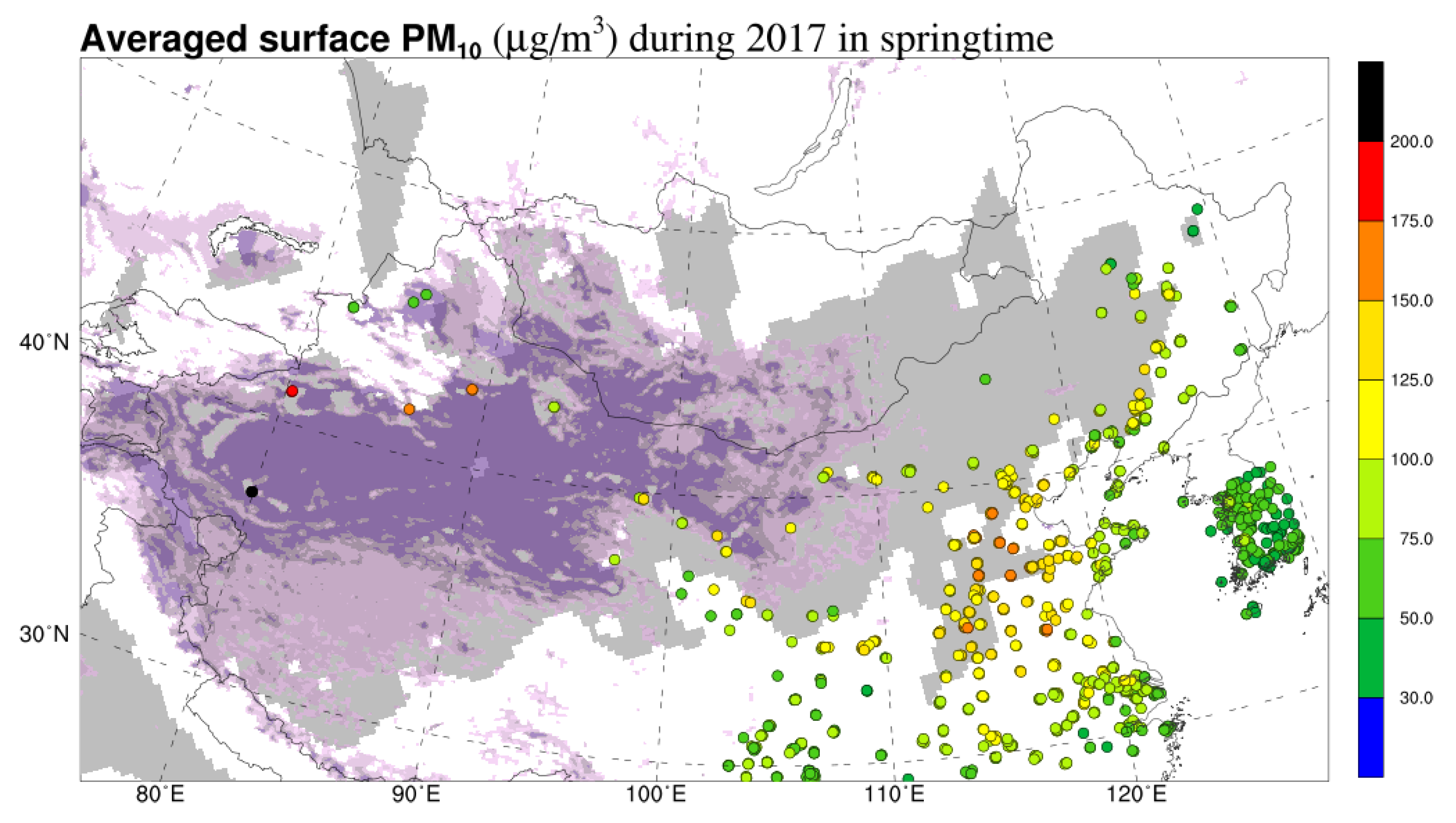
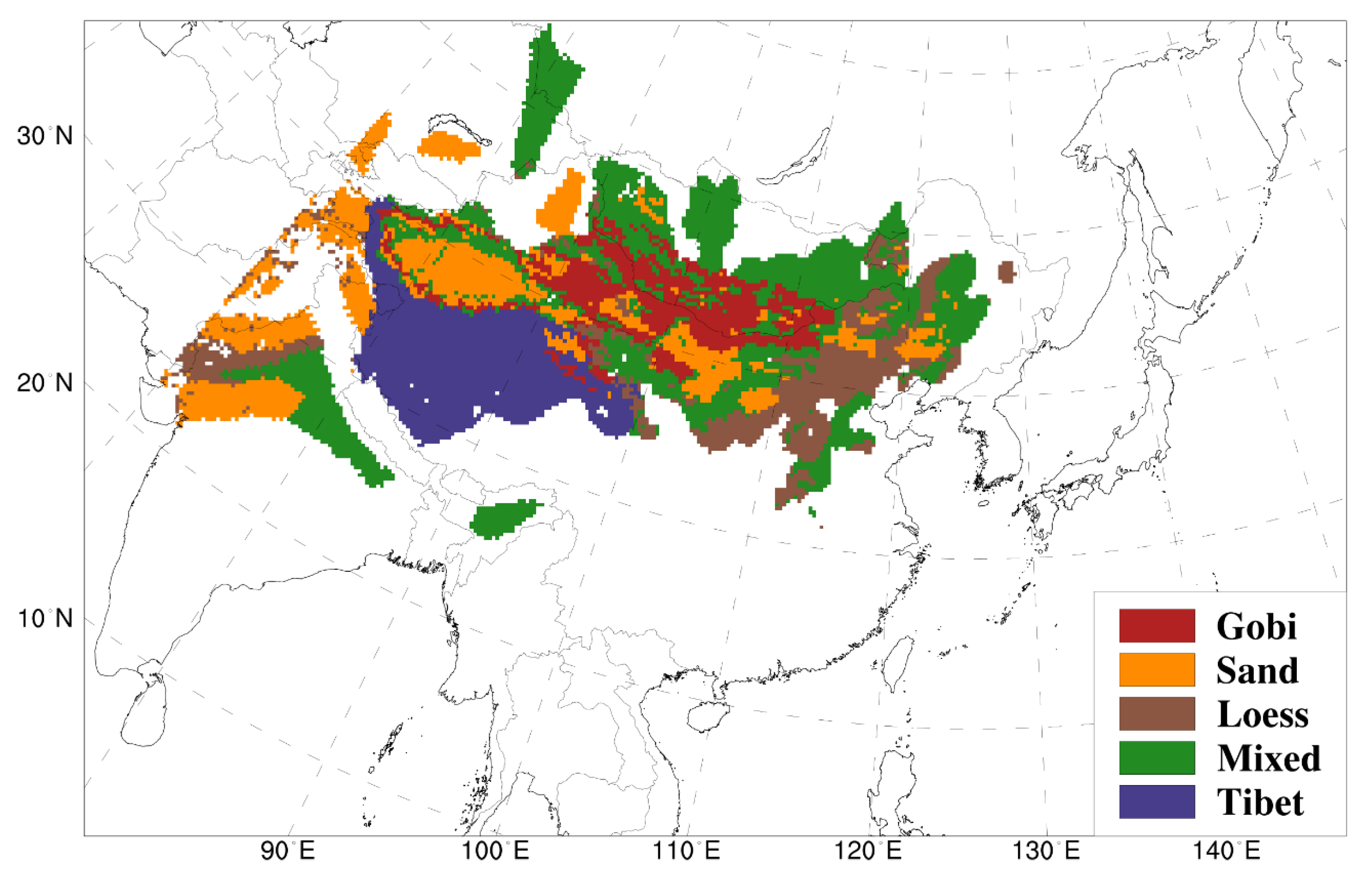
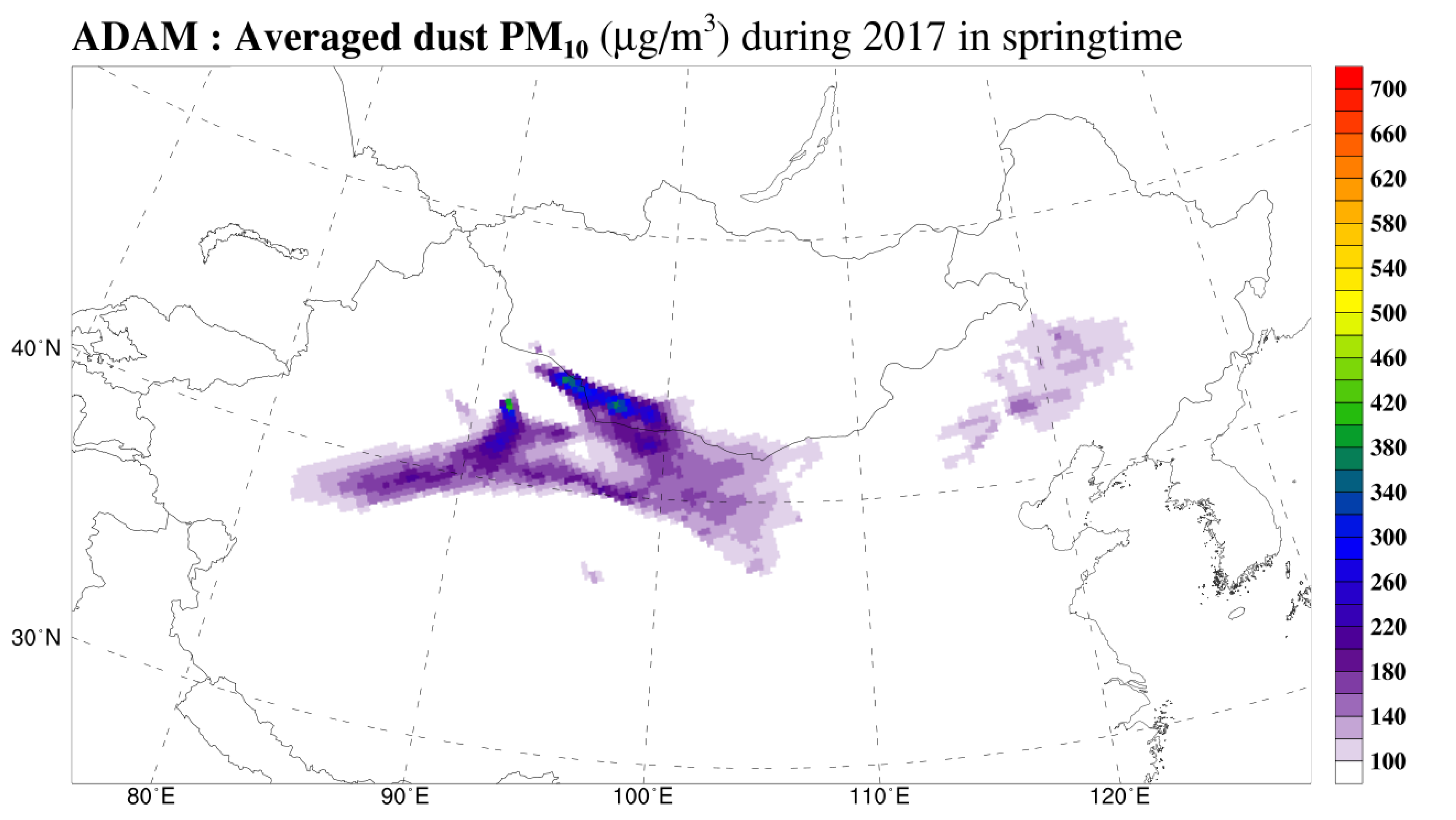
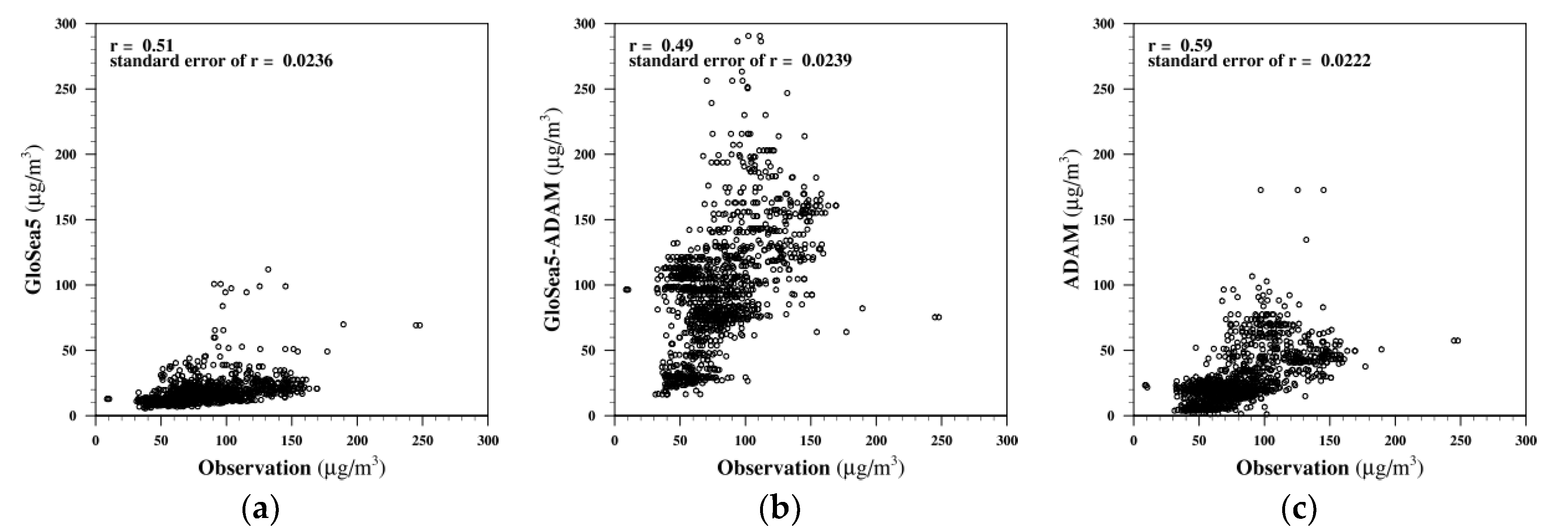
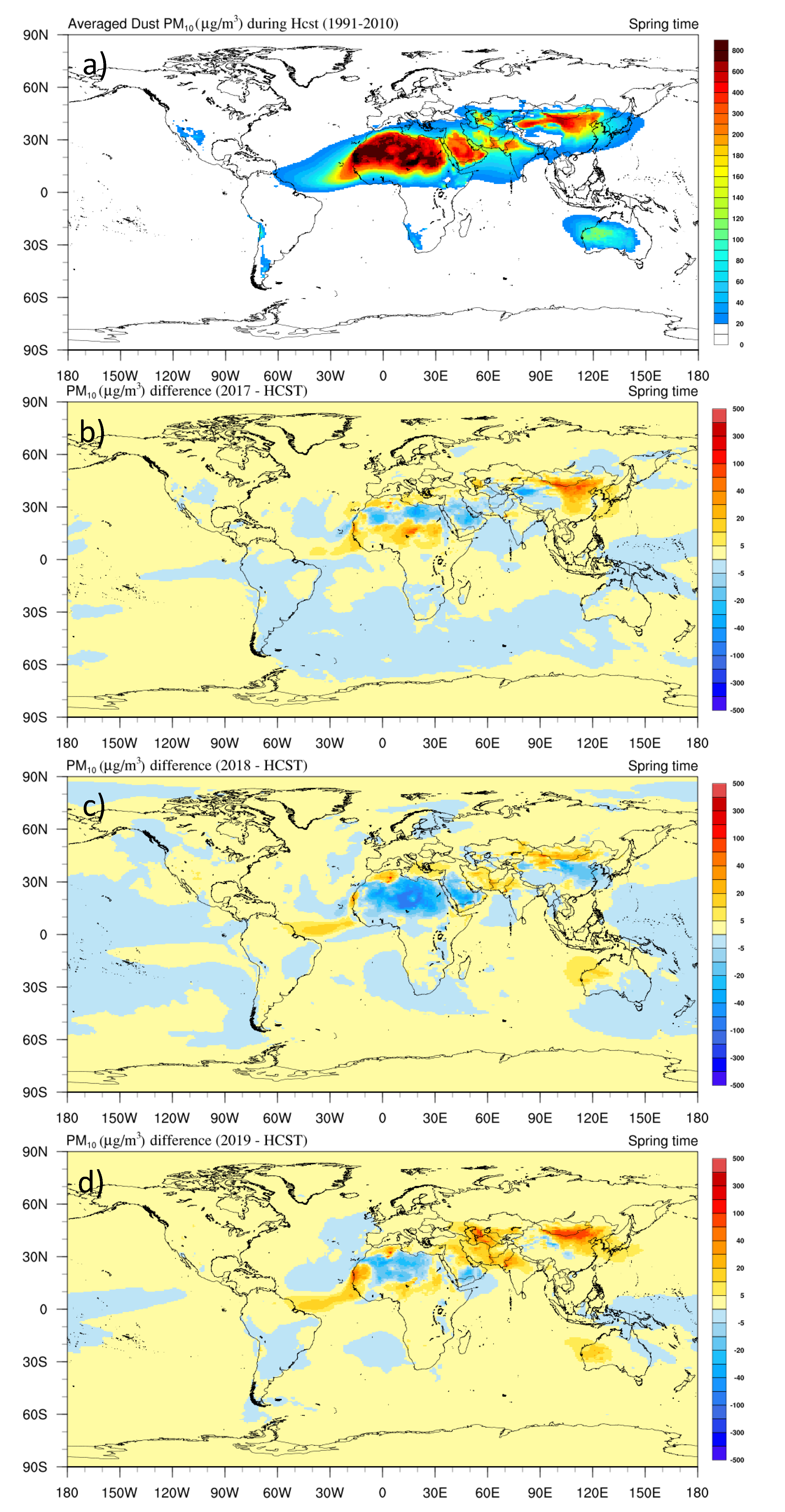
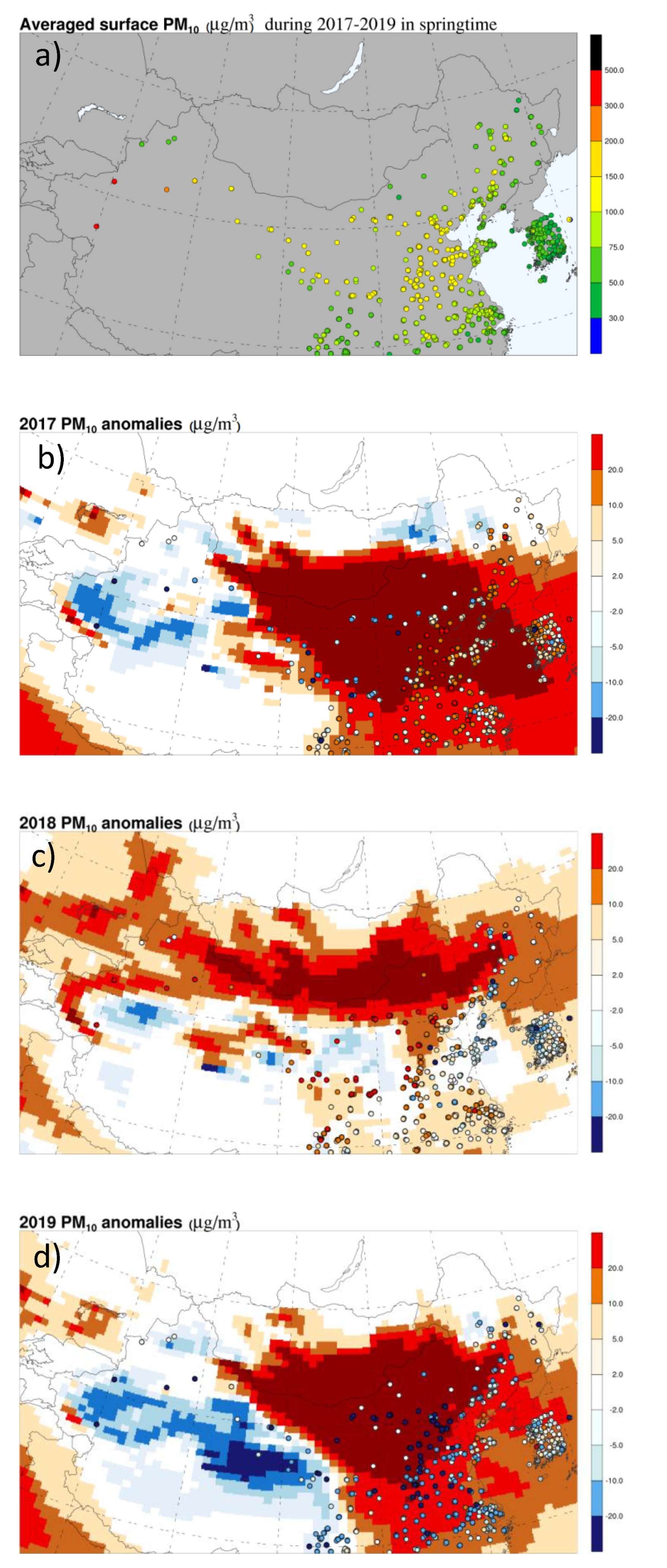
| Observation | Above Normal | Normal | Below Normal | |
|---|---|---|---|---|
| GloSea5-ADAM | ||||
| Above Normal | 3 | 0 | 3 | |
| Normal | 2 | 5 | 1 | |
| Below Normal | 2 | 2 | 2 | |
© 2020 by the authors. Licensee MDPI, Basel, Switzerland. This article is an open access article distributed under the terms and conditions of the Creative Commons Attribution (CC BY) license (http://creativecommons.org/licenses/by/4.0/).
Share and Cite
Ryoo, S.-B.; Lim, Y.-K.; Park, Y.-S. Seasonal Asian Dust Forecasting Using GloSea5-ADAM. Atmosphere 2020, 11, 526. https://doi.org/10.3390/atmos11050526
Ryoo S-B, Lim Y-K, Park Y-S. Seasonal Asian Dust Forecasting Using GloSea5-ADAM. Atmosphere. 2020; 11(5):526. https://doi.org/10.3390/atmos11050526
Chicago/Turabian StyleRyoo, Sang-Boom, Yun-Kyu Lim, and Young-San Park. 2020. "Seasonal Asian Dust Forecasting Using GloSea5-ADAM" Atmosphere 11, no. 5: 526. https://doi.org/10.3390/atmos11050526
APA StyleRyoo, S.-B., Lim, Y.-K., & Park, Y.-S. (2020). Seasonal Asian Dust Forecasting Using GloSea5-ADAM. Atmosphere, 11(5), 526. https://doi.org/10.3390/atmos11050526




